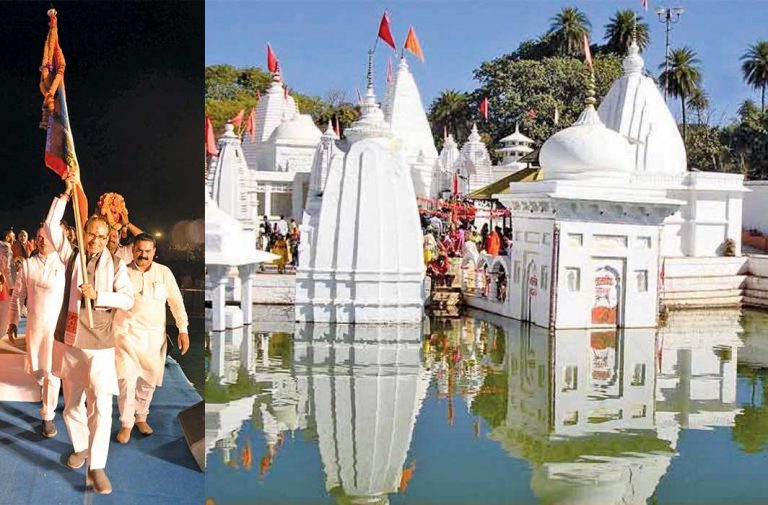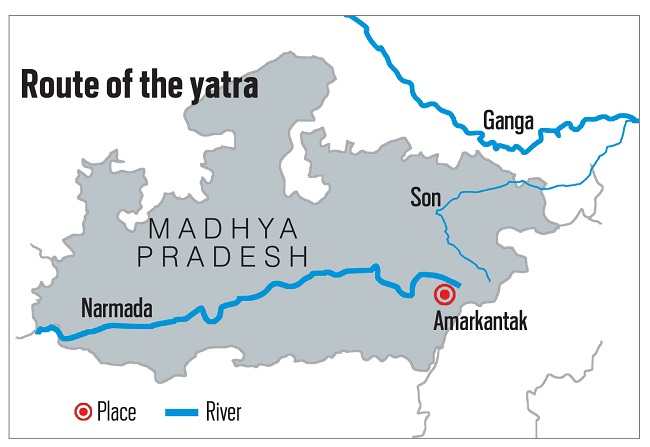
The NGT intervened to halt the state government’s ambitious plan to mobilise five lakh people for the closing ceremony of the Narmada Sewa Yatra
~By Rakesh Dixit in Bhopal
Thanks to the timely intervention of the National Green Tribunal (NGT), an environmental disaster comparable to the one that hit the Yamuna floodplains in Delhi last year was averted at Amar-kantak in Madhya Pradesh. This is where three rivers—the Narmada, Son and Johilla—commence their journey through the dusty plains of central India.
If the Yamuna floodplains were stressed by the World Culture Festival of spiritual guru Sri Sri Ravi Shankar’s Art of Living (AOL), then Amarkantak in the Vindhya ranges faced a similar prospect when the Madhya Pradesh government as well as BJP leaders announced a plan to mobilise five lakh people for a function to mark the culmination of the 146-day long Narmada Sewa Yatra at Amarkantak on May 15. The Yatra, ironically, was meant to be an exercise to conserve the Narmada but has invited much criticism for being a political mobilisation programme. Prime Minister Narendra Modi was the chief guest at the function at Amarkantak.
The announcement to mobilise a huge crowd in the hill town rang an ominous bell and the NGT stepped in to minimise the damage. Two weeks ahead of the scheduled function, the NGT’s central bench at Bhopal sought a report from the district magistrate of Anuppur and the state government on the measures taken to check pollution at Amarkantak on a petition filed by activist Sanjiv Tiwari. The petition apparently had a sobering effect on the government.
The district magistrate stated in his reply that the state government expected a crowd of one-and-a-half lakh and not five lakhs as advertised earlier. The crowd on May 15 at the Amarkantak function was around one lakh.
The state government also clarified that the culmination ceremony was not a religious occasion, so “no one will be allowed to take a holy dip in the river during or after the event”. Judicial member Justice Dalip Singh and expert member Satyawan Singh Garbyal directed officials to monitor the quality of water regularly and present it before the court. In the next hearing of NGT slated on May 27, the government is expected to give a compliance report of the measures taken to prevent pollution.
Petitioner Sanjiv Tiwari says that but for the NGT’s intervention, the state government would have gone ahead with its original plan, causing extensive damage to the heritage site of Amarkantak as well as the river. “This betrayed the chief minister’s hypocrisy about cleaning the Narmada River,” he says.
Senior Congress leader Digvijaya Singh alleges that the chief minister launched the yatra to deflect people’s attention from rampant illegal sand mining by BJP leaders and their cohorts. Issuing licences for sand mining in rivers is one of the most prevalent practices of this government to dispense favour to ruling party leaders at the lower level. In fact, the alleged involvement of the chief minister’s kin and BJP leaders in illegal sand mining is a major political issue in the state for the last decade.

According to the leader of the opposition in the Madhya Pradesh assembly, Ajay Singh, Chief Minister Shivraj Singh Chouhan must be aware that his nephew is excavating sand illegally in the Jahajpura area without environment clearances. He dares the CM to make public the names of the two companies which have been allotted 450 out of the 586 sand mines. The Congress alleges that one of the two companies—the Shiva Corporation—has business partnership with the chief minister’s kin.
Only two months ago, the mining department had seized trucks overloaded with illegally mined sand in Bhopal. The trucks were registered in the name of the chief minister’s nephew Pradyumn Singh. MP Congress president Arun Yadav says illegal sand mining is rampant in the chief minister’s Budni constituency in Sehore district. “More than 800 to 1,000 trucks are used every day for illegal mining by the mafia in adjacent areas,” alleged Yadav in a letter to the Prime Minister Narendra Modi ahead of the latter’s visit to Amarkantak. Evidence of illegal mining in the state was also attached with the letter.
Congress leader Digvijaya Singh alleges that the CM launched the yatra to deflect people’s attention from illegal sand mining by BJP leaders and their cohorts
The NGT too has expressed grave concern over wanton perforation of large swathes of the Narmada riverbed across Madhya Pradesh from time to time while hearing petitions over the matter. Exasperated over the government’s inaction in checking illegal sand mining, the tribunal had imposed a blanket ban on sand mining in July, 2015 for the monsoon (June 1 to October 31). However, it lifted the ban three months later with certain riders.
Meanwhile, the Tribunal is still seized of a bunch of petitions filed by Narmada Bachao Andolan (NBA) activist Medha Patkar and others seeking total ban on sand mining in four districts in western Madhya Pradesh—Dhar, Badwani, Khargone and Alirajpur.
The Tribunal also has several other petitions before it, seeking strict government crackdown against the sand mining mafia across the state. In the latest case, the tribunal on April 28 expressed displeasure over delay in filing first information reports (FIRs) against culprits. The two-member bench of Justices Daleep Singh and SS Garbyal was particularly angry over non-implementation of the Tribunal’s directives to put in place a system for monitoring illegal mining through GPS, and e-monitoring.
The Tribunal feels such an electronic monitoring system is necessary in view of the large number of complaints of illegal mining received by the mining department. Besides, mining mafias often violently clash with the police and mining and forest department officials when their vehicles laden with illegally mined sand are intercepted. In 2016 alone, more than 13,000 cases of illegal mining were reported in the state.
Alleged political patronage to mining mafia under the Shivraj Singh Chouhan government has also caused massive resentment among people living on the banks of the Narmada. Against the backdrop of the growing public anger over sand mining, the chief minister rolled out a grandiose plan to conserve the river through 146 days of Narmada Sewa Yatra. Its stated objectives were: To increase awareness about the need for conservation of the Narmada and sustainable use of its resources; planting trees on the banks to reduce soil erosion; to promote eco-friendly agricultural practices and to identify various sources of river pollution. Significantly, checking illegal mining was conspicuously absent among the objectives.
The chief minister flagged off the Yatra at Amarkantak on December 11 amid elaborate religious rituals. From then on, the CM and his wife remained “pilgrims” all through 146 days of the Yatra that covered nearly 3,000 km in circumambulation of the river from its origin in Amarkantak to Alirajpur on the MP-Gujarat border. An entourage of 50 pilgrims travelled through 600 villages spread across 52 blocks in 16 districts. More importantly, the Narmada Yatra winded through 96 of the state’s 230 assembly segments.
From day one, it was clear that the pilgrimage was more a political project with an eye on the assembly elections due in 2018 than a concerted initiative to de-pollute the river. It was dominated by pujas, chanting of mantras, flag bearing and religious discourses by assorted sadhus. Thousands of BJP workers were mobilised for gathering crowds.
Officials said that over 24 lakh people attended 1,000-plus programmes held as part of the Yatra. About 80,000 volunteers registered themselves for the campaign. The Chouhans attended a large number of the programmes which were suffused with religious symbolism.

The government spent huge sums advertising the Yatra in various media outlets across the country. Over 600 noted personalities, including half-a- dozen Union ministers, UP chief minister Yogi Adityanath, the Dalai Lama, Baba Ramdev, film stars Govinda and Jackie Shroff, environmentalists, etc, attended the Yatra at various stages.
The chief minister kept the campaign in the news by announcing a slew of measures to clean the river. These included a ban on liquor shops within a five km radius of the river and planting of five crore saplings along the riverbed.
However, in none of his effusively devotional speeches to save Narmada Mata did the chief minister touch upon the secular concern for checking illegal sand mining.
That was perhaps one of the reasons why the Narmada Sewa Yatra failed to enthuse people. Although the government advertisements claimed it was the biggest people’s movement in the world for river conservation, the media outside Madhya Pradesh largely ignored it. This did not escape the notice of the prime minister when he attended the concluding function at Amarkantak on May 15. Modi wondered if the grand initiative did not attract due media attention nationally just because a politician was heading it.

